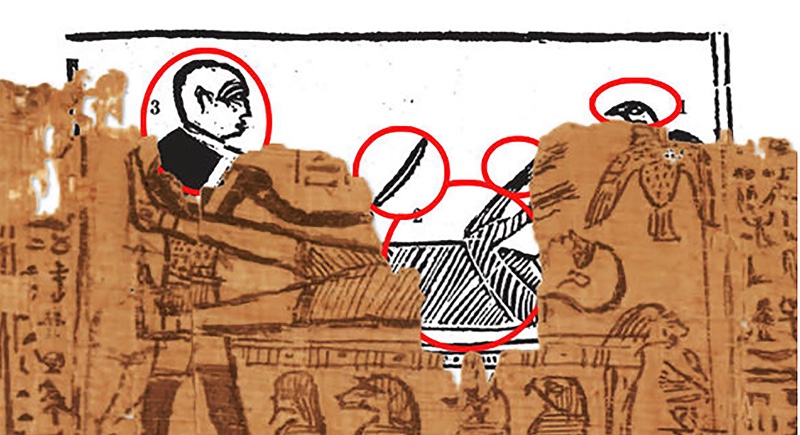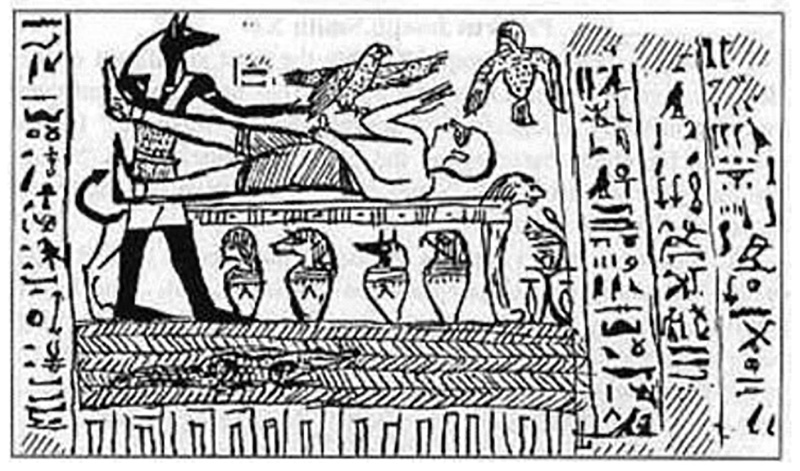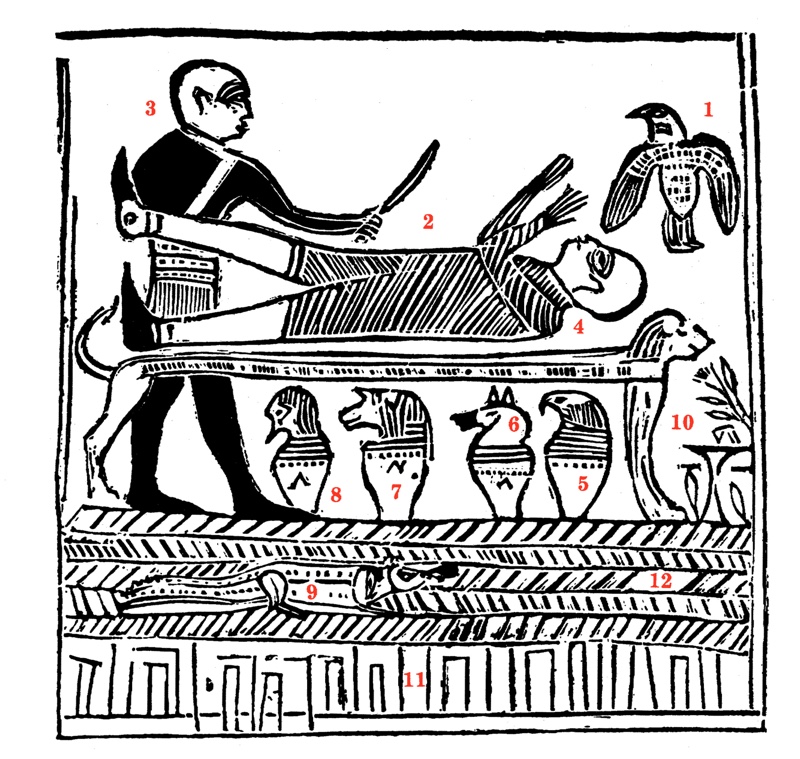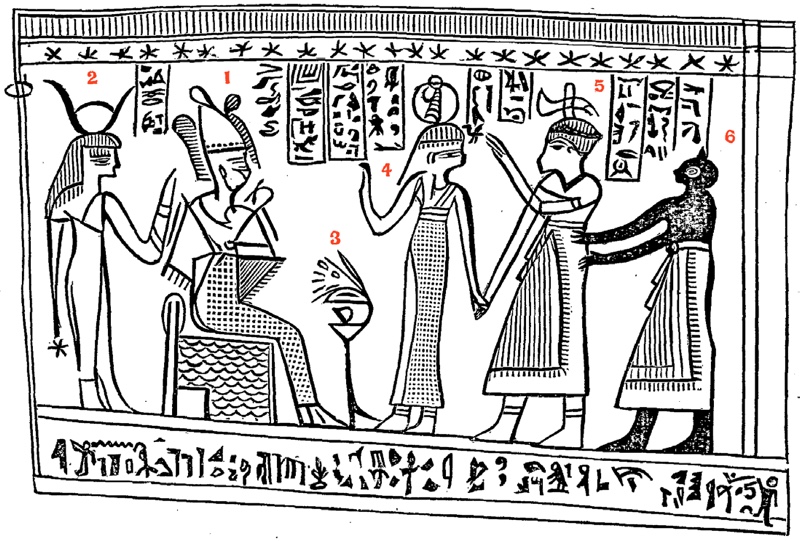None of the characters on the papyrus fragments mentioned Abraham’s name or any of the events recorded in the book of Abraham. Mormon and non-Mormon Egyptologists agree that the characters on the fragments do not match the translation given in the book of Abraham, though there is not unanimity, even among non-Mormon scholars, about the proper interpretation of the vignettes on these fragments. Scholars have identified the papyrus fragments as parts of standard funerary texts that were deposited with mummified bodies. These fragments date to between the third century B.C.E. and the first century C.E., long after Abraham lived.
Papyrus Found
Originally, Joseph claimed that this record was written by Abraham “by his own hand, upon papyrus” – a claim still prominent in the heading of the Book of Abraham. This claim could not be evaluated for decades as many thought the papyri were lost in a fire. The original papyrus Joseph translated has since been found and, as stated in the Church’s July 2014 Translation and Historicity of the Book of Abraham essay, “scholars have identified the papyrus fragments as parts of standard funerary texts...[that] date to between the third century B.C.E. and the first century C.E., long after Abraham lived.”
We know this is the papyrus that Joseph used for translation because the hieroglyphics match in chronological order to the hieroglyphics in Joseph’s Kirtland Egyptian Papers, which contains his Grammar & Alphabet of the Egyptian Language (GAEL). Additionally, the papyrus were pasted onto paper which have drawings of a temple and maps of the Kirtland, Ohio area on the back and they were companied by an affidavit by Emma Smith verifying they had been in the possession of Joseph Smith.
Common Pagan Funerary Text
Egyptologists have also since translated the source material for the Book of Abraham and have found it to be nothing more than a common pagan Egyptian funerary text for a deceased man named “Hor” around first century C.E. In other words, it was a common Breathing Permit that the Egyptians buried with their dead. It has nothing to do with Abraham or anything Joseph claimed in his translation for the Book of Abraham. The Church admits this in its essay:
None of the characters on the papyrus fragments mentioned Abraham’s name or any of the events recorded in the book of Abraham. Mormon and non-Mormon Egyptologists agree that the characters on the fragments do not match the translation given in the Book of Abraham, though there is not unanimity, even among non-Mormon scholars, about the proper interpretation of the vignettes on these fragments. Scholars have identified the papyrus fragments as parts of standard funerary texts that were deposited with mummified bodies. These fragments date to between the third century B.C.E. and the first century C.E., long after Abraham lived.
Facsimile 1



Joseph Smith's Interpretation | Modern Egyptological Interpretation | |
|---|---|---|
| 1. | The Angel of the Lord | The spirit or “ba” of Hôr (The deceased fellow) |
| 2. | Abraham fastened upon an altar | The deceased: His name was “Hôr” |
| 3. | The idolatrous priest of Elkenah | Anubis. (see original image, this figure was originally portrayed with the head of a Jackal) |
| 4. | The altar for sacrifice by the idolatrous priests, standing before the gods of Elkenah, Libnah, Mahmackrah, Korash, and Pharoah | A common funeral bier or "lion couch" |
| 5. | The idolatrous god of Elknah |
Canopic jars containing the deceased’s internal organs. They represent the four sons of the god Horus, who are:
|
| 6. | The idolatrous god of Libnah | |
| 7. | The idolatrous god of Mahmackrah | |
| 8. | The idolatrous god of Korash | |
| 9. | The idolatrous god of Pharaoh | This is the god “Horus” |
| 10. | Abraham in Egypt | A libation table bearing wines, oils, etc. Common in Egypt |
| 11. | Designed to represent the pillars of heaven, as understood by Egyptians | A palace facade, called a “serekh” |
| 12. | Raukeeyang, signifying expanse, or the firmament over our heads; but in this case, in relation to this subject, the Egyptians meant it to signify Shaumau, to be hig, or the heavens, answering to the Hebrew word Shaumahyeen | This is just the water that the crocodile swims in |
- Joseph Smith’s Translations: Facsimile 1 in Book of Abraham
- Modern Egyptological Translations
- FairMormon Facsimile 1 Apologetics (notice FairMormon attempts to distract away from line by line translations and instead goes off in irrelevant tangents about sacrifice and other nonsense.)

Facsimile 2

Joseph Smith's Interpretation | Modern Egyptological Interpretation | |
|---|---|---|
| 1. | Kolob, The residence of God | The god Khnumu |
| 2. | Stands next to Kolob, called by the Egyptians Oliblish... | “Amun-Re”, god with two faces representing rising & setting sun |
| 3. | God sitting on his throne, clothed with power and authority | “Horus-Re” riding in his boat |
| 4. | Raukeeyang; also the number 1000; The measuring of time of Oliblish | Represents Sokar, not a number |
| 5. | Enish-go-on-dosh; a governing planet | Cow of Hathor behind which stand a uzat-headed goddess holding a sacred tree |
| 6. | Represents this earth in its four quarters | The four sons of Horus, they can represent the four cardinal points of earth |
| 7. | God sitting on his throne, revealing through the heavens the grand Keywords of the priesthood | The god “Min”, an ithyphallic god; that is, a sexually aroused male deity |
| 8. | Contains writings that can only be revealed in the temple | “grant that the souls of Osiris Shechonk may live” |
| 9. | Ought not to be revealed at the present time | “the netherworld (below the earth) and his great waters. |
| 10. | Ought not to be revealed at the present time | Oh might god, lord of heaven and earth |
| 11. | O god of the sleeping ones from the time of creation (read in order 11,10,9,8) | |
| 12. | Will be given in the own due time of the Lord | “near” and “wrap” |
| 13. | “which made by” | |
| 14. | “breathings” | |
| 15. | “this book” | |
| 16. | “and may this soul and its posessor never be decreased in the netherworld” | |
| 17. | “may this tomb never be desecrated” | |
| 18. | “I am Djabty in the house of Benben in Heliopolis, so exalted and glorious. (I am) copulating bull without equal. (I am) that mighty god in the house of Benben of Heliopolis... that might god...” | |
| 19. | "You shall be as that God, the Busirian" | |
| 20. | ||
| 21. | ||
| 22. | No Annotation Given | "The name of this mighty god" |
| 23. | Baboons are adoring the souls of that realm |
- Joseph Smith’s Translations: Facsimile 2 in Book of Abraham
- Modern Egyptological Translations
- FairMormon Facsimile 2 Apologetics (Joseph may have gotten 1 out of 21 translations correct!)
One of the most disturbing facts I discovered in my research of Facsimile 2 is figure #7. Joseph Smith said that this is “God sitting on his throne...” It’s actually Min, the pagan Egyptian god of fertility or sex. Min is sitting on a throne with an erect penis (which can be seen in the figure). In other words, Joseph interpreted that this figure with an erect penis is Heavenly Father sitting on His throne.
Facsimile 3

Joseph Smith's Interpretation | Modern Egyptological Interpretation | |
|---|---|---|
| 1. | Abraham sitting on Pharaoh's throne, by the politeness of the king, with a crown upon his head, representing the priesthood, as emblematical of the grand Presidency in heaven; with the scepter of justice and judgment in his hand | This is Osiris. Writing above figure: "Recitation by Osiris, Foremost of the Westerners." The "atef" crown also identifies him as Osiris |
| 2. | King Pharaoh, whose name is given in the characters above his head | This figure is female, not male. Writing above figure: "Isis the great, the god's mother |
| 3. | Signifies Abraham in Egypt as given also in Figure 10 of Facsimile No. 1. | This is a libation table (wine, oils, etc.) |
| 4. | Prince of Pharaoh, King of Egypt, as written above the hand | This figure is female, not male. Writing above figure: "Maat, mistress of the gods" |
| 5. | Shulem, one of the kings principal waiters, as represented by the characters above his hand | This is a deceased individual wearing the traditional cone of perfumed grease and lotus flower on his head. Writing above figure: "The Osiris Hor, justified forever" |
| 6. | Olimlah, a slave belonging to the prince | Not a slave. This is Anubis, guide of the dead, who is there to support the deceased. Writing above figure: "Recitation by Anubis, who makes protection(?), foremost of the embalming booth, ..." |
- Joseph Smith’s Translations: Facsimile 3 in Book of Abraham
- Modern Egyptological Translations
- FairMormon Facsimile 3 Apologetics (“There are LDS experts who believe the Book of Abraham is a genuine artifact, and that it testifies of Joseph Smith’s status as a prophet. Non-LDS experts obviously do not agree with that.”)
Facsimile Summary
Respected non-LDS Egyptologists state that Joseph Smith’s translation of the papyri and facsimiles are gibberish and have absolutely nothing to do with the papyri and facsimiles and what they actually say.
Facsimile 1
- The names are wrong.
- The Abraham scene is wrong.
- He names gods that are not part of the Egyptian belief system; of any known mythology or belief system.
Facsimile 2
- Joseph translated 11 figures on this facsimile. None of the names are correct and none of the gods exist in Egyptian religion or any recorded mythology.
- Joseph misidentifies every god in this facsimile.
Facsimile 3
- Joseph misidentifies the Egyptian god Osiris as Abraham.
- Misidentifies the Egyptian god Isis as the Pharaoh.
- Misidentifies the Egyptian god Maat as the Prince of the Pharaoh.
- Misidentifies the Egyptian god Anubis as a slave.
- Misidentifies the dead Hor as a waiter.
- Joseph misidentifies – twice – a female as a male.
Cosmology
The Book of Abraham teaches an incorrect Newtonian view of the universe. These Newtonian astronomical concepts, mechanics, and models of the universe have since been succeeded and substantially modified by 20th century Einsteinian physics.
What we find in Abraham 3 and the official scriptures of the LDS Church regarding science reflects a Newtonian world concept. Just as the Catholic Church's Ptolemaic cosmology was displaced by the new Copernican and Newtonian world model, however, the nineteenth-century, canonized, Newtonian world view has since been displaced by Einstein's twentieth-century science.
Keith E. Norman, an LDS scholar, has written that for the LDS Church:
It is no longer possible to pretend there is no conflict.
Norman continues:
Scientific cosmology began its leap forward just when Mormon doctrine was becoming stabilized. The revolution in twentieth-century physics precipitated by Einstein dethroned Newtonian physics as the ultimate explanation of the way the universe works. Relativity theory and quantum mechanics, combined with advances in astronomy, have established a vastly different picture of how the universe began, how it is structured and operates, and the nature of matter and energy. This new scientific cosmology poses a serious challenge to the Mormon version of the universe.
Grant Palmer, a Mormon historian and CES teacher for 34 years, wrote:
Many of the astronomical and cosmological ideas found in both Joseph Smith’s environment and in the Book of Abraham have become out of vogue, and some of these Newtonian concepts are scientific relics. The evidence suggests that the Book of Abraham reflects concepts of Joseph Smith’s time and place rather than those of an ancient world.
King James Version Text
86% of Book of Abraham chapters 2, 4, and 5 are King James Version Genesis chapters 1, 2, 11, and 12. Sixty-six out of seventy-seven verses are quotations or close paraphrases of King James Version wording. (See An Insider’s View of Mormon Origins, p.19)
If the Book of Abraham is an ancient text written thousands of years ago “by his own hand upon papyrus,” then what are 17th century King James Version text doing in there? What does this say about the book being anciently written by Abraham?
Anachronisms
Why are there anachronisms in the Book of Abraham? For example, the terms Chaldeans, Egyptus, and Pharaoh are all anachronistic. Additionally, Abraham refers to the facsimiles in 1:12 and 1:14. However, as noted and conceded above in the Church’s essay, these facsimiles did not even exist in Abraham’s time as they are standard first century C.E. pagan Egyptian funerary documents.
Some have assumed that the hieroglyphs adjacent to and surrounding facsimile 1 must be a source for the text of the book of Abraham.
Why would anyone assume that?
Light from Kolob
Facsimile 2, Figure #5 states the sun receives its “light from the revolutions of Kolob.” We now know, however, that the process of nuclear fusion is what makes the stars and suns shine. With the discovery of quantum mechanics, scientists learned that the sun’s source of energy is internal and not external. The sun shines because of thermonuclear fusion. The sun does not shine because it gets its light from any other star or any other external source.
The Philosophy of a Future State
There is a book published in 1829 by Thomas Dick entitled The Philosophy of a Future State. Joseph Smith owned a copy of the book and Oliver Cowdery quoted some lengthy excerpts from the book in the December 1836 Messenger and Advocate.
Klaus Hansen, an LDS scholar, stated:
The progressive aspect of Joseph’s theology, as well as its cosmology, while in a general way compatible with antebellum thought, bears some remarkable resemblances to Thomas Dick’s ‘Philosophy of a Future State’.
Hansen continues:
Some very striking parallels to Smith’s theology suggest that the similarities between the two may be more than coincidental. Dick’s lengthy book, an ambitious treatise on astronomy and metaphysics, proposed the idea that matter is eternal and indestructible and rejected the notion of a creation ex nihilo. Much of the book dealt with the infinity of the universe, made up of innumerable stars spread out over immeasurable distances. Dick speculated that many of these stars were peopled by ‘various orders of intelligences’ and that these intelligences were ‘progressive beings’ in various stages of evolution toward perfection. In the Book of Abraham, part of which consists of a treatise on astronomy and cosmology, eternal beings of various orders and stages of development likewise populate numerous stars. They, too, are called ‘intelligences.’ Dick speculated that ‘the systems of the universe revolve around a common centre...the throne of God.’ In the Book of Abraham, one star named Kolob ‘was nearest unto the throne of God.’ Other stars, in ever diminishing order, were placed in increasing distances from this center.
Elder Holland BBC Interview
Elder Jeffrey R. Holland was directly asked about the papyri not matching the Book of Abraham in a March 2012 BBC interview:
Mr. Smith got this papyri and he translated them and subsequently as the Egyptologists cracked the code something completely different...
(Interrupts) All I’m saying...all I’m saying is that what got translated got translated into the word of God. The vehicle for that, I do not understand and don’t claim to know and know no Egyptian.
Is “I don’t know and I don’t understand but it’s the word of God” really the best answer that a “prophet, seer, and revelator” can come up with to such a profound problem and stumbling block that is driving many members out of the Church?
The following are respected Egyptian scholars/Egyptologists statements regarding Joseph Smith and the Book of Abraham:
...these three facsimiles of Egyptian documents in the Pearl of Great Price depict the most common objects in the Mortuary religion of Egypt. Joseph Smith’s interpretations of them as part of a unique revelation through Abraham, therefore, very clearly demonstrates that he was totally unacquainted with the significance of these documents and absolutely ignorant of the simplest facts of Egyptian writing and civilization.
It may be safely said that there is not one single word that is true in these explanations.
It is difficult to deal seriously with Joseph Smith’s impudent fraud... Smith has turned the goddess [Isis in Facsimile #3] into a king and Osiris into Abraham.
In addition to the above, world renowned and respected University of Chicago professor of Egyptology, Dr. Robert Ritner, provided a detailed response and rebuttal to the LDS Church’s Translation and Historicity of the Book of Abraham essay that is sobering and devastating. Dr. Ritner’s rebuttal to the Church’s essay can be read here.
The following video offers a thorough, complete, and unbiased overview of the Book of Abraham issues as well as the apologetic responses to them:
An online contributor created an easy-to-understand document very clearly outlining the Book of Abraham issues. Contrary to what some Mormon apologists claim or imply, a person does not have to be an Egyptologist or a scholar with a PhD to clearly understand the Book of Abraham problems and challenges to Joseph Smith’s claims of being a translator.
Of all the issues, the Book of Abraham is the issue that has both fascinated and disturbed me the most. It is the issue that I’ve spent the most time researching because it offers a real insight into Joseph’s modus operandi as well as Joseph’s claim of being a translator. It is the smoking gun that has completely obliterated my testimony of Joseph Smith and his claims.